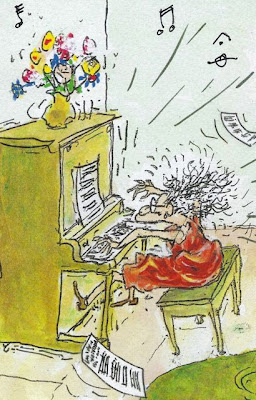A few months ago a next-door neighbor in the process of downsizing was was happy to give us a 100-year-old Aeolian (the Volkswagen of pianos in the first half of the 20th C, long ago eviscerated of its player mechanism) for the cost (in muscular energy) of moving it from his living room -- and precariously rolling it down the street -- into our living room. The ancient beast can still almost play a Mozart sonata by itself. Instead of a piano in the parlor most Americans have a home theater system in the living room and an iPod in their pockets, and offspring, talented or not, strum an electronic instrument in their bedroom or garage.
So I can boast that in more civilized places like Mt. Gretna a surprising number of grand pianos, Steinways and Bechsteins among them, still slumber quietly in dark ancient cottages, some tended with loving care by retired music teachers.
When I learned that the Board of Directors of Elizabethtown College had purchased a Steinway Grand for the Leffler stage to honor the 15-year tenure of President Ted and Betty Long, I must admit I was perplexed. There were already two Baldwin pianos on the stage, one of them ours, which, which regulated and voiced properly (they usually were not), could produce a sound indistinguishable from a Steinway, at least to the ears of >99% of the listeners. I could think of other ways of making music better at the college, ways that, as the Longs illustrated so perfectly, involve people rather than instruments or buildings: an endowed artist professorship, for example, or a permanent residency for an eminent ensemble of artist teachers. But then many other gifts would have been even less appropriate: a gala concert by a 'superstar' whose fee approached or exceeded the cost of the Steinway. That would have been soon forgotten and illustrated only the lack of a relationship between the quality of music and its perceived monetary value. The Steinway should allow for exquisite performances for the remaining existence of humanity on planet earth.
 |
| New Yorker, Jan 30, 2012 |
For our part in honoring the Longs we conceived the "Monsters of the Steinway" concerts that will begin on November 17 and extend into next Fall. This winter the new Steinway will deliver performances of Bach’s Goldberg Variations under the capable hands of Anne-Marie McDermott (November 17); Beethoven’s Hammerklavier Sonata with Joel Fan (February 23); and in a special recital by one of our time’s most celebrated keyboard artists, Emanuel Ax (March 19). Rest assured that "Monsters" does not refer to any of the pianists but rather to their monumental repertoire: the Goldberg's, the Hammerklavier, Schubert's B-flat Major Sonata, and Ives' Concord Sonata. The complete programs are on GretnaMusic.org and the next edition of this blog will preview the November 17 performance of The Goldbergs.

I grew in a musically inclined family. All of my aunts know how to play the piano so every reunion they never fail to give us their masterpieces. I fell in love with the music so I ask my grandmother if I can have her piano. Now it's sitting in my living room.
ReplyDeleteCharlottesvillePiano.com